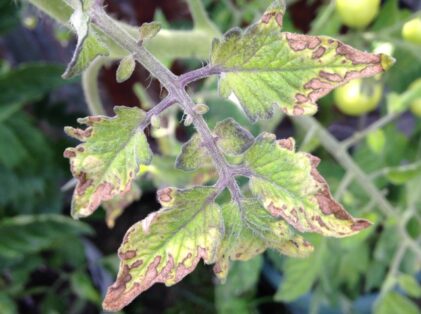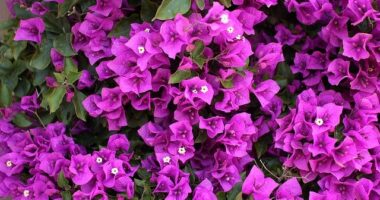The potassium plays a role of regulator of the vital functions of the plant: assimilation of chlorophyll, resistance to diseases, cold and drought, regulation of transpiration.
Although most plants like potassium, some are more sensitive to lack of it than others:
Small fruits plant (blackcurrant, redcurrant), fruit trees (apple, pear, apricot, lemon) and vegetables in general (zucchini, potato, tomato …).
Contents
The role of potassium in plants
Potassium is always abundant in the dry matter of plants. It is absorbed by the roots in the form of the K+ cation, and circulates in this form throughout the plant.
Its functions in plant metabolism are multiple:
- It maintains the port of the plant by its major effect on the turgidity of the cells and the constitution of resistant cell walls.
- It acts on photosynthesis
- by activating more than 80 enzyme systems
- It promotes the circulation of sap ascending in the xylem and descending in the phloem. It allows the transfer of assimilates (sugars, amino acids) to the roots and reserve organs (grains, fruits, tubers).
- It controls the opening and closing of the stomata.
- and regulates the water cycle in the plant.
- It intervenes on the composition and quality of many productions (sugar/acidity balance, vitamin C content, aromatic compounds, fiber quality…).
There is an interaction between nitrogen and potassium, in the sense that the plant that is better fed with nitrogen will need more potassium. Nitrogen has the effect of increasing the foliar index of a crop. In order to maintain the turgidity of this leaf surface and of the stems and roots, the plant needs more potassium.
Symptoms of potassium deficiency
To find out if you need to add potash, soil analysis is ideal. If it reveals a potassium level of less than 2 for a clay level below 20%, a potash deficiency is apparent. However, you can observe your crops:
- in the vegetable garden, if the leaf margins turn brown, if spots or rust appear, a potash deficiency is likely,
- In the orchard, if your fruits are small and not very sweet, if there are chlorosis attacks, leaf curling and necrosis, you should certainly add potash,
- in weeds, if nettles and quackgrass are present, your soil is rich enough in potash!
You can also touch the soil: a clay soil is naturally rich in potassium while a soil that lacks limestone is also low in potash.
With all that has been poured in chemical fertilizers over the last few decades, the soil in France is globally rich in potassium, and deficiencies are limited. It should also be noted that an excess of potash in turn leads to calcium and magnesium deficiencies, and makes plants more susceptible to diseases and pests of all kinds.
How do you add potassium to soil?
All plants need a certain amount of nitrogen, phosphorus and potassium in order to grow. The latter plays an active role in the synthesis of plant proteins and regulates the flow of water in the plant. It is essential for the health of the plant. You can buy it like many other chemicals, but if you have an organic garden, there are more environmentally friendly substitutes that you can use.

What is a natural source of potassium for plants?
Algae
Especially the brown algae, are rich in potash and trace elements. Seaweed products are sold in organic stores if you don’t have the opportunity to go and collect some on the beach. Attention, you will have to make them desalinate under the rain or by rinsing before using them: in compost, in mulching or in maceration.
Comfrey
Comfrey is rich in potash and phosphorus, which makes it very useful in the vegetable garden to produce aromatic, fruit and root vegetables of all beauty, not forgetting its benefit on roses whose flowering it supports. In addition, it protects plants from diseases by improving their ability to absorb potash and other nutrients from the soil. Prepare comfrey manure and water it diluted at 10%.
Wood Ash
Rich in potash and lime, wood ash should only be used in small doses.
The Guano
From the accumulation of seabird droppings and corpses, is especially rich in nitrogen, but its potassium content is far from negligible.
The Patentkali
It is a very soluble crushed rock which brings a lot of potash.
Why you should use potash fertilizer
Potash fertilizer is mainly used to make up for potassium deficiencies in cultivated plants and to improve yields.
It is important to know that a plant lacking in potassium can cause atrophied growth, browning and stunting, which is detrimental to the development of the plant and therefore to its yield. In addition, a plant in a state of potassium deficiency will be much more vulnerable to various attacks and diseases.
Thanks to the potash fertilizer, these phenomena will be stopped and reversed. Potash has an “enhancing” effect, allowing better growth and resistance. It increases the sugar content of the fruit. Actions that act even on plants that are not in a state of deficiency.
In addition to increasing the development of tubers, fruits and roots tenfold, potash fertilizer also reduces water stress (water rejection phenomenon).
Do coffee ground contain potassium?
Coffee grounds contain potassium, magnesium and nitrogen. These properties are particularly interesting for your vegetable garden.
Indeed, potassium and magnesium are immediately assimilated by the plants. As for nitrogen, which is released more gradually, it is useful for plants.
Coffee grounds are rich in nutrients and also represent a contribution in terms of organic matter.
Summary
Potassium helps to strengthen plant cell walls and increase leaf area and chlorophyll content of the leaves, resulting in delayed leaf senescence. Therefore, it contributes to increase canopy photosynthesis and crop growth.
The plants most sensitive to a lack of potassium are small fruits (blackcurrant, redcurrant), fruit trees (pear tree, vine), vegetables (potato, tomato).









